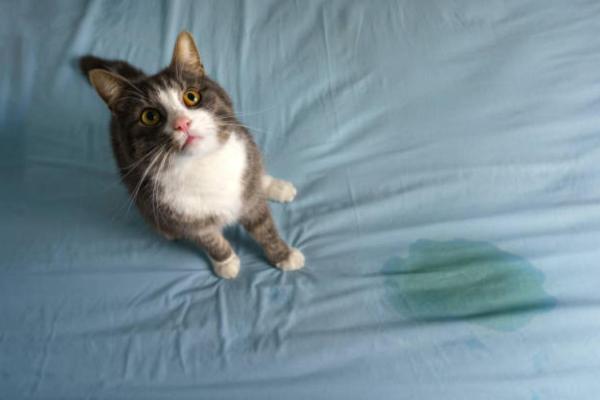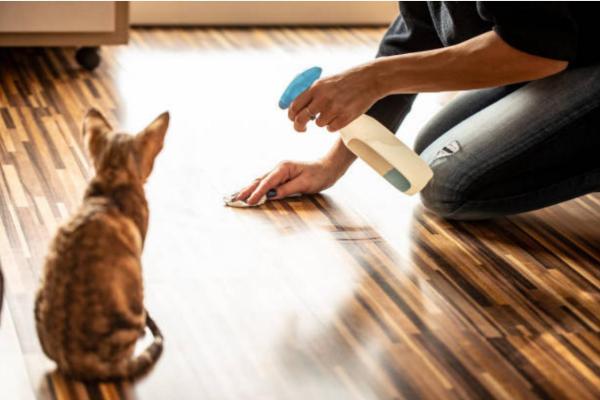Is Cat Pee Dangerous?



See files for Cats
Beyond just a bathroom break, cat pee plays a big role in feline communication. They mark territory and send messages with their urine. But what happens when your cat's bathroom habits change? Strong odors, frequent urination, or blood in the pee can be cause for concern.
Is cat pee dangerous? This is a common worry for cat owners. This AnimalWised article dives into this question, exploring potential concerns and offering solutions.
What is cat pee?
Cat pee, also known as feline urine, is a waste product eliminated by cats through their kidneys and bladder. It serves two primary purposes:
- Waste elimination: cat pee expels metabolic waste products created by the body's breakdown of food and other substances.
Communication: cats can communicate a lot through their urine. They can mark territory, advertise their reproductive status, and even express stress or anxiety by leaving urine deposits.
Composition and characteristics of cat urine
Cat urine is a complex mixture of water, organic and inorganic solutes, and cellular material. Here's a breakdown of its key components:
- Water
- Urea
- Creatinine
- Electrolytes
- Uric Acid
- Ammonia
- Ph Level
Ever wonder what message your cat is trying to send through their pee? Dive deeper into feline communication and why they might mark their territory in our related article.
Is cat pee dangerous to humans?
Cat pee can irritate humans in a couple of ways, but it's generally not a major cause for concern.
However, it is important to note that cat urine can harbor bacteria and parasites that can potentially transmit diseases to humans, like leptospirosis and (rarely) toxoplasmosis. These diseases are more likely to spread through contact with infected feces, but minimizing risk is important. Always wash your hands thoroughly after handling litter boxes or cleaning up accidents.
Furthermore, cat urine is high in ammonia, a gas that can irritate the eyes, nose, and throat. Inhaling high levels, particularly from unclean litter boxes, can trigger coughing, wheezing, and difficulty breathing. People with asthma or other respiratory conditions are more vulnerable.
Cat urine can trigger allergic reactions in some people, causing symptoms like itchy eyes, runny nose, and skin irritation.
Last but not least, uncleaned cat urine can stain carpets, furniture, and other surfaces, leaving behind unpleasant odors. This can be bothersome for both you and your cat.
Is your cat mistaking your favorite sweater for a giant litter box? Our next article offers solutions to this temporary wardrobe crisis.

Dangers of cat urine for your health
While cat urine is generally not harmful to humans, it can serve as a valuable indicator of a cat's health status. Understanding these signs can help pet owners identify potential problems and seek timely veterinary care.
On one hand, blood in a cat's urine, known as hematuria, can be a sign of various health conditions such as trauma, urinary tract infections, kidney stones, or viral diseases. Immediate veterinary attention is essential for an accurate diagnosis and appropriate treatment to ensure the cat's well-being and prevent potential complications.
On the other hand, excessive urination can be a symptom of Feline Lower Urinary Tract Disease (FLUTD). However, it can also be related to territorial marking, especially in newly introduced cats. Urine marking is distinguishable from regular urination as it is often done in a spraying manner, with the cat standing up and lifting its tail. If increased urination is observed, it's crucial to determine the underlying cause to address any potential health issues or behavioral concerns.
Finally, cats may engage in urine marking as a way to define their territory or cope with stress and changes in their environment. Factors such as the introduction of a new cat without proper acclimation, an inadequately enriched environment, or other disturbances can trigger this behavior. Recognizing the underlying cause is vital for addressing the issue effectively and restoring the cat's emotional well-being.
This is why it is so important to monitor any changes in your cat's urination habits and behaviors, since they can provide valuable insights into their health and well-being. If you notice any unusual signs or symptoms, it's essential to consult with a veterinarian promptly to ensure proper diagnosis and treatment.
Is your cat straining in the litter box or going less frequently? These could be signs of a urinary issue. Learn more about the causes and potential solutions in our related article.
What to use to clean cat urine?
Maintaining a clean and odor-free home is crucial when living with cats. Effective cleaning of cat urine requires the use of safe and efficient products that can completely eliminate stains and odors while ensuring the hygiene of the living environment. Various products are available on the market, each offering unique benefits for cleaning cat pee effectively:
- Enzymatic cleaners: these cleaners contain enzymes that break down and digest urine stains, effectively eliminating unpleasant odors. Enzymatic cleaners are particularly effective for cleaning carpets, fabrics, and other porous surfaces where urine can penetrate.
- Specific urine cleaning products: these are specialized detergents designed for cleaning fabrics and carpets, formulated to remove urine stains and associated odors. They often contain cleaning and bleaching agents that can effectively remove cat urine, leaving fabrics and carpets clean and fresh.
- Multi-surface cleaners or household disinfectants: suitable for hard surfaces like tile, linoleum, or wood floors, these products are designed to remove dirt, bacteria, and odors, ensuring a clean and hygienic environment. However, it's advisable to avoid cleaners containing bleach or ammonia, as they may encourage cats to continue marking with urine.
- White vinegar or baking soda: white vinegar possesses antibacterial and deodorizing properties, while baking soda is effective in neutralizing odors. You can mix equal parts of white vinegar and water or create a paste using baking soda and water. Apply the solution to the urine stain, let it sit for a few minutes, then wipe it off with a clean cloth.
Regardless of the cleaning method you choose, prompt action is crucial when dealing with cat urine. Cleaning fresh urine before it dries can simplify the process and minimize lingering odors. Additionally, it's advisable to test any cleaning product on a small, inconspicuous area first to ensure compatibility and avoid potential damage to the surface.
Think you've eliminated the source of the odor, but that lingering smell just won't quit? Our next article offers solutions for dealing with even the most persistent cat urine smells.
This article is purely informative. AnimalWised does not have the authority to prescribe any veterinary treatment or create a diagnosis. We invite you to take your pet to the veterinarian if they are suffering from any condition or pain.
If you want to read similar articles to Is Cat Pee Dangerous?, we recommend you visit our Other health problems category.






